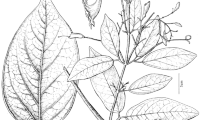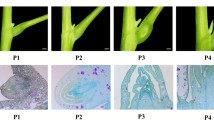Abstract
Embryological characters of Siparunaceae, which are poorly understood, were studied on the basis of two constituent genera, an African Glossocalyx and a South American Siparuna, to better understand their evolution within Laurales. These two genera have many embryological characteristics in common with the other lauralean families. Noticeably, they share the multi-celled ovule archesporium (uncertain in Glossocalyx) as a synapomorphy with all the other lauralean families except Lauraceae, the anthers dehisced by valves as a synspomorphy with all the other lauralean families except Calycanthaceae and Monimiaceae, and the bisporangiate anther as a synapomorphy with Gomortegaceae and Atherospermataceae. Siparunaceae are, however, distinct from all other laularean families in having unitegmic ovules that were derived from bitegmic ovules, probably due to an elimination of the outer integument. Likewise, the lack of the testa (i.e., developed outer integument), the "endotegmic" seed coat, and the perichalazal seed at maturity are also characteristics of Siparunaceae. Within the family, Siparuna differs from Glossocalyx in having plural tetrads of megaspores and plural, starchy-rich, one-nucleate, tubular embryo sacs (autapomorphies). On the other hand, Glossocalyx is characterized by having bilaterally flattened seeds (autapomorphy). Although functional aspects of those autapomorphies are uncertain, both Glossocalyx and Siparuna show evolution in different embryological characters.









Similar content being viewed by others
References
Corner EJH (1949) The annonaceous seed and its four integuments. New Phytol 48:332–364
Corner EJH (1976) The seeds of the dicotyledon, vols 1 and 2. Cambridge University Press, Cambridge, UK
Endress PK (1972) Zur vergleichenden Entwicklungsmorphologie: Embryologie und Systematik bei Laurales. Bot Jahrb Syst 92:331–428
Endress PK, Igersheim A (1997) Gynoecium diversity and systematics of the Laurales. Bot J Linn Soc 125:93–168
Heilborn O (1931) Studies on the taxonomy, geographical distribution and embryology of the genus Siparuna. Svensk Bot Tidskr 25:202–228
Herr JM (1974) A clearing-squash technique for the study of ovule and megagametophyte development in angiosperms. In: Radford AE et al (eds) Vascular plant systematics. Harper and Row, New York, pp 230–235
Kimoto Y, Tobe H (2001) Embryology of Laurales: a review and perspectives. J Plant Res 114:247–267
Philipson WR (1987) A classification of the Monimiaceae. Nordic J Bot 7:25–29
Philipson WR (1993) Monimiaceae. In: Kubitszki K et al (eds) The families and genera of vascular plants, vol 2. Springer, Berlin Heidelberg New York, pp 426–437
Renner SS, Hausner G (1997) Siparunaceae. In: Harling G, Andersson L (eds) Flora of Ecuador, vol 59. Council for Nordic Publications in Botany, Copenhagen, ISSN 0347-8742, pp 1–98
Renner SS, Won H (2001) Repeated evolution of dioecy from monoecy in Siparunaceae (Laurales). Syst Biol 50:700–712
Renner SS, Schwarzbach AE, Lohmann L (1997) Phylogenetic position and floral function of Siparuna (Siparunaceae: Laurales). Int J Plant Sci 158[Suppl]:S89–S98
Schmid R (1986) On cornerian and other terminology of angiospermous and gymnospermous seed coats: historical perspective and terminological recommendations. Taxon 35:476–491
Soejima A (1990) The histogenesis of integuments in some species of Menispermaceae. Bot Mag (Tokyo) 103:209–216
Tobe H, Raven PH (1984) The number of cells in the pollen of Melastomataceae (Myrtales). Bot Mag (Tokyo) 97:131–136
Tokuoka T, Tobe H (2001) Ovules and seeds in subfamily Phyllanthoideae (Euphorbiaceae): structure and systematic implications. J Plant Res 114:75–92
Tokuoka T, Tobe H (2002) Ovules and seeds in subfamily Euphorbioideae (Euphorbiaceae): structure and systematic implications. J Plant Res 115:361–374
Acknowledgements
We are grateful to Peter H. Raven, James C. Solomon, Peter C. Hoch, Williams A. Haber, Susanne S. Renner, and M. Kropffand for their assistance in obtaining materials used in the present study, and to Kweon Heo and Ryoko Imaichi for their technical advice in the use of Technovit. The present study was supported by a Grant-in-Aid for Scientific Research from the Japan Society for the Promotion of Science (no. 14405012).
Author information
Authors and Affiliations
Corresponding author
Rights and permissions
About this article
Cite this article
Kimoto, Y., Tobe, H. Embryology of Siparunaceae (Laurales): characteristics and character evolution. J Plant Res 116, 281–294 (2003). https://doi.org/10.1007/s10265-003-0091-9
Received:
Accepted:
Published:
Issue Date:
DOI: https://doi.org/10.1007/s10265-003-0091-9




